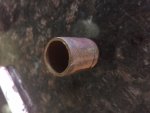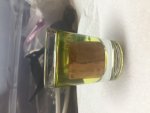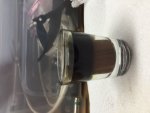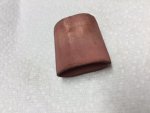Perhaps this has already been hashed out. I read the previous threads, but they ended in 2007 so the fancy technology told me to post a new one.
The basic message I got from the prior thread was that MA *might* damage your equipment, with the copper pipe in your heater being the most vulnerable, followed by pump seals.
I've been adding MA to me skimmer for some time and noticed no problems, just assuming the dilution and short exposure would be OK. But the other thread alarmed me a bit, and it ended with essentially the message "we need some empirical testing"
So, I performed a really basic test. I took a short piece of standard 3/4" copper plumbing tubing, and put it in a shotglass of undiluted 31.45% MA.
Within less than a minute I could see that the MA had an effect on the tubing, essentially scouring off the oxidization. So I covered it with some saran wrap and left it in my garage while travelling for a week. Today I inspected it: the MA had discolored with some sort of blackish debris which floated to the top of the shot glass. I took out the copper, rinsed it off, and found the copper tube to be a bit pitted, but I found no observable change in it's thickness. In hindsight I probably should have used calipers to measure it, but oh well.
I then smacked it with a hammer to see if it had any structural damage. It of course bent, but did not lose its integrity.
If standard copper tubing can withstand a full week in full strength MA, I cannot see how diluted through the skimmer for 15 seconds per week can cause any damage. Maybe I'm missing something...
I've attached pictures, but not sure they tell the whole story.
Bob
The basic message I got from the prior thread was that MA *might* damage your equipment, with the copper pipe in your heater being the most vulnerable, followed by pump seals.
I've been adding MA to me skimmer for some time and noticed no problems, just assuming the dilution and short exposure would be OK. But the other thread alarmed me a bit, and it ended with essentially the message "we need some empirical testing"
So, I performed a really basic test. I took a short piece of standard 3/4" copper plumbing tubing, and put it in a shotglass of undiluted 31.45% MA.
Within less than a minute I could see that the MA had an effect on the tubing, essentially scouring off the oxidization. So I covered it with some saran wrap and left it in my garage while travelling for a week. Today I inspected it: the MA had discolored with some sort of blackish debris which floated to the top of the shot glass. I took out the copper, rinsed it off, and found the copper tube to be a bit pitted, but I found no observable change in it's thickness. In hindsight I probably should have used calipers to measure it, but oh well.
I then smacked it with a hammer to see if it had any structural damage. It of course bent, but did not lose its integrity.
If standard copper tubing can withstand a full week in full strength MA, I cannot see how diluted through the skimmer for 15 seconds per week can cause any damage. Maybe I'm missing something...
I've attached pictures, but not sure they tell the whole story.
Bob





